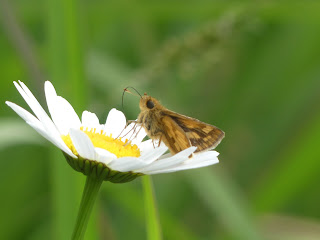Wilke's Mining Bee
There are a bunch of bees around here; this 1 is (probably) a Wilke's Mining Bee. (A very technical description is here.) This is not a native bee, though they've been over here for a long time. There's a theory that they made the trip over here within ship ballast. Not unlike European humans, they've spread out and thrived over here, probably at the expense of native residents [1].
Although these bees are known to like pollinating legumes like clovers and Bird's-foot Trefoil, that's not a hard-and-fast rule; this bee seems to be enjoying a Common Yarrow.
Despite evolving on a different continent, they do have fairly close relatives in the US. We have mining bees here, and all mining bees are in the same genus. They get their name from a tendency to dig holes in the ground, but they're not looking for precious metals; that's where the nests for their offspring will reside [2].
These bees were named by the 19th century entomologist William Kirby, but it's not known why he honored a family or individual named Wilkes.
 |
| June 15, 2023 at Sourland Mountain Preserve Photo 300990065, (c) jpviolette, some rights reserved (CC BY-NC) |
[1] Or maybe they don't interfere much with our native bees. They seem to gravitate towards "disturbed areas" where at least some native species might not feel at home.
[2] Don't automatically think that any bee making a nest in the dirt is a mining bee; lots of other bees do this too.



Comments
Post a Comment